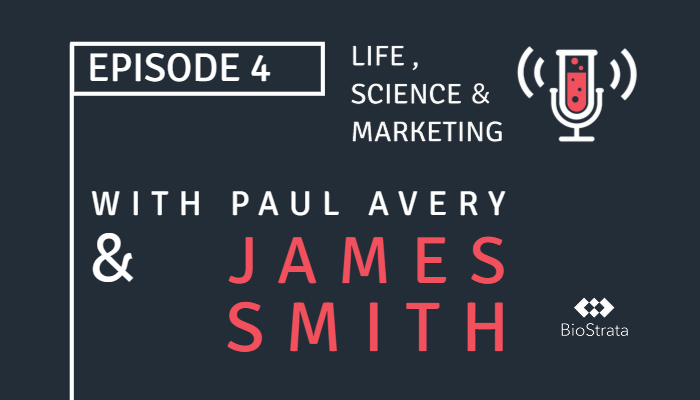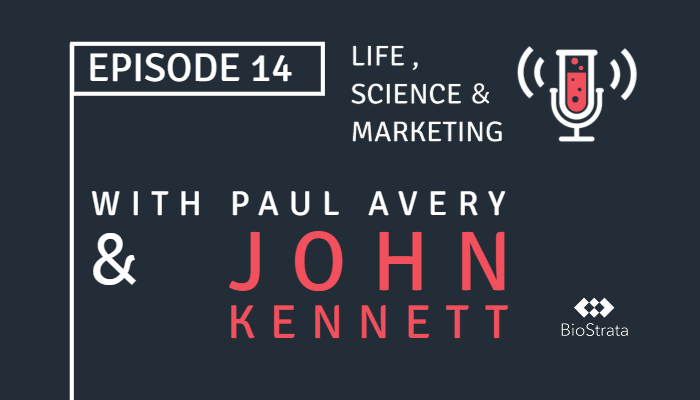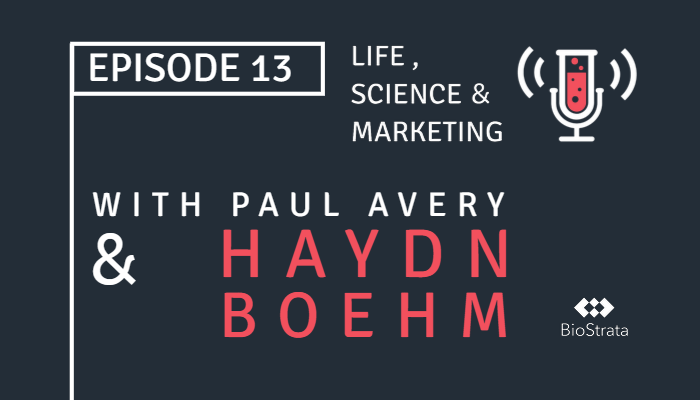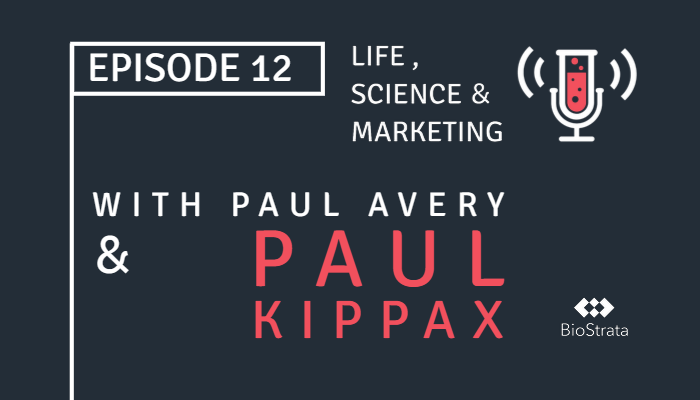James Smith: Insights on brand building, managing global teams, emerging tactics and understanding post-pandemic customer psychology.
Our "Life, Science and Marketing" podcast features in-depth discussions between host and BioStrata CEO Paul Avery and science marketing professionals from across the globe. In each episode, guests share their backgrounds, motivations, and advice on marketing strategies and best practices.
In the latest episode, Paul had an engaging discussion with James Smith, Global Marketing Director at SPT Labtech. With over 17 years of experience in life science marketing, including 13 years helping build the Envigo brand, James provided a fascinating perspective on managing global teams, understanding customer psychology, and avoiding “shiny ball syndrome” when evaluating new marketing tactics.
Read on for a summary of episode 4 and James’ journey from hospitality marketing to leading global marketing initiatives in the life sciences industry. You can also listen to the full conversation in the podcast episode below or find us on your favourite podcast platform.
How did you get started in marketing and what was your path to your current role?
James Smith: After university, my first proper job was as a concierge at the Cambridge Hilton Hotel. I worked my way into the sales office as a coordinator and was able to carve out a marketing manager role at the hotel for a while. This got noticed by the regional lead for Holiday Inn and Crown Plaza hotels, and I became a regional marketing manager covering 12 hotels in the London and East Anglia area. This gave me my first real marketing experience beyond just making posters at the hotel.
I later moved into a law firm marketing role, but didn't enjoy it as much as the hotel world. So when a role came up at ProQuest, similar to Elsevier and Cambridge University Press, I took it as my first management position leading a team with people globally. I loved the energy of that global marketing role. Unfortunately, there were redundancies, so when a marketing officer role came up at Huntington, later known as Envigo, I took it despite having no life sciences experience.
That kicked off 13 years at Envigo, starting from knowing nothing about drug development to gradually learning the industry and the buyers' needs. When Envigo acquired Harlan Laboratories, I led the rebranding initiative to form the new Envigo brand and relaunch it globally. Three years ago, I joined SPT Labtech as Global Marketing Director to help accelerate science.
What did you find most challenging about managing remote teams when you first started out?
James Smith: I was quite naive initially about managing remote teams globally. This was pre-Zoom when emails and phone calls were the main ways to communicate. I learned over that first 6 months to get a common process in place so we could align our efforts and support each other better. Building personal connections through one-on-one and face-to-face time during periodic onsite visits was crucial. Understanding the local needs versus global priorities took empathy and partnerships with the local managers.
What's your advice for marketing professionals just starting out in their careers?
James Smith: Listen more than you speak. Don't try to impress people too quickly. Join meetings and conversations where you can learn, even if you're not directly invited. Build your network by listening first to understand. You'll gain insights much faster by having casual conversations than trying to come in and dictate how things should be done as the marketing expert.
What buyer psychology shifts have you noticed post-pandemic, and how should marketers adapt?
James Smith: It's a confused state now regarding digital versus human engagement. People want the energy of live events again but retain some of the flexibility of remote work. Attention is fractured across more digital channels than ever, yet direct mail that cuts through to the physical world can be very impactful when done strategically.
My advice to marketers is don't get pulled towards every digital shiny new object right now. Go back to fundamentals, and talk to your customers and prospects. Understand their specific journeys. Don't assume their needs based on generic data points. Do they need to level up their knowledge or be spoken to as experts? How can you cut through the noise to deliver what they truly need right now? Test and learn what marketing channels and messages work for your specific audience post-pandemic.
How can marketers determine attribution and quantify marketing impact as tracking gets more difficult?
James Smith: The buyer journey is getting more complicated across more platforms. As third-party cookies go away and Apple limits email tracking, the digital footprint is shrinking. So what will help marketers gain clearer attribution to truly understand ROI? It may get harder before solutions arise. Companies want marketing efficiency quantified, so we need better ways to track the full journey. This will be a big challenge over the next few years - refining attribution models when everything leans towards dark social where the full story is unknown.
What marketing trends are you paying attention to for the next 12-24 months?
James Smith: It's hard to predict the next big trend right now. Things like AI and new digital communities are interesting but take time to properly evaluate. I believe going back to fundamentals - truly understanding your customers and their journeys - is critical in this confusing post-pandemic period, rather than chasing generic data points.
Cut through the noise by delivering what your specific audience needs. Test and learn what works for them across channels and messaging. Don't just assume their needs or jump on every shiny new object. Lay a strong foundation first, maximize what you have, and then you can smartly assess emerging tactics when the time is right.
What skills will be most valuable for marketers to develop over the next 5 years?
James Smith: The role of marketing has massively expanded beyond just creating posters and flyers. Data analysis, technology, and legal/compliance knowledge are integral today. I'm fascinated to see what competencies will be most sought after going forward.
Will data science become even more important as we try to quantify impact and refine attribution models? How about customer experience and voice of the customer capabilities? It's an exciting time to be in marketing, though the core purpose remains connecting with audiences.
To drive growth, we need adaptable teams combining creativity, analytical rigour, and customer insight. Cross-functional dexterity will be hugely valuable. It's about attracting and empowering the right blend of talent to accelerate science and business goals.
What's the biggest lesson you've learned over your marketing career?
James Smith: Over my career, the biggest lesson I’ve learned is to avoid “shiny ball syndrome” at all costs. It’s easy to get sucked into constantly exploring new marketing tactics and trends before you’ve mastered current essentials. There are so many shiny new objects you could chase - a never-ending parade of AI, new tech, and hot channels. It’s tempting to jump into evaluating each one, asking how can we incorporate this into our strategy?
But I've found that obsession over the latest shiny ball can be a distraction and a waste of time. You can spend endless hours down rabbit holes thinking this new tactic or technology is the perfect next step for you. Yet in the end, it can be a complete waste if it's not grounded in marketing fundamentals.
My advice is to step back, maximize what you already have in place, and don’t assume you need to constantly change everything. Really master your current strategies. Go back to basics like truly understanding your customers’ needs. Don’t just jump onto the next shiny object because it seems cool and new. Lay a strong foundation first, then you can smartly evaluate trends. But avoid “shiny ball syndrome” chasing what’s hot without results.
What marketing campaign or program are you most proud of in your career so far?
James Smith: Looking back, I’m most proud of leading the extensive Envigo rebranding and launch campaign. When Huntington acquired Harlan and we had to form a new unified brand, it was an enormous undertaking. We took the company through an in-depth brand strategy process to define our positioning. Then we rolled out Envigo globally across 53 sites in 14 countries - a massive effort to get alignment.
Executing a coordinated branded campaign across every channel to thousands of employees and the market was extremely energizing. From concept to actuality, it was rewarding to see the strategy come to life. Building the right team and working cross-functionally was key to success. My partner in crime on it was Jim Regan - we brought together a phenomenal group.
The hardest part was gaining internal buy-in from people attached to the legacy brands. After working under those names for years, they were sceptical of the change. But we focused them on how this new brand and culture could accelerate science. That ultimately rallied our internal audience around a shared mission.
The impact of developing Envigo from scratch and ushering in an entirely new brand system is my proudest career achievement so far. It took leadership, strategy, and company-wide collaboration. And it was a huge milestone on my own journey as a marketer.
More marketing insights with the Life, Science & Marketing Podcast
As we wrap up this engaging discussion with James Smith, we'd like to thank him for openly sharing his extensive marketing wisdom and experiences. James welcomes further conversations and is happy to provide more perspective on his career journey - you can connect with him on LinkedIn.
Stay tuned for future episodes of the "Life, Science & Marketing" podcast. We look forward to bringing you more thought-provoking insights and practical advice from top marketing professionals in the life sciences sphere.
You can also follow the official Life, Science and Marketing LinkedIn page to keep up with the latest podcast news, episodes, and marketing best practices.




